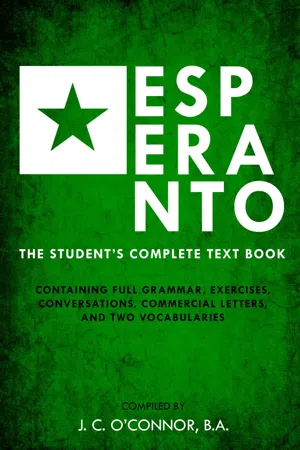
Esperanto (the Universal Language)
The Student's Complete Text Book; Containing Full Grammar, Exercises, Conversations, Commercial Letters, and Two Vocabularies
- English
- ePUB (mobile friendly)
- Available on iOS & Android
Esperanto (the Universal Language)
The Student's Complete Text Book; Containing Full Grammar, Exercises, Conversations, Commercial Letters, and Two Vocabularies
About this book
Anyone who has ever traveled knows the challenge of language barriers. These are caused by the different languages and dialects across the world. Perhaps the solution to those barriers lies within this book.
This is an entry-level text for learning the language of Esperanto. Unlike nearly every other language on Earth, Esperanto is a constructed language, created by Dr. L. L. Zamenhoej in the late 19th century. This book contains not only the vocabulary, mechanics, grammar, and syntax of Esperanto, but also the hopes and dreams of Dr. Zamenhoej. His goal was to create an easy to understand language that the whole world could learn to tear down an ancient barrier that had kept people apart. As George Soros put it - "Esperanto was a very useful language, because wherever you went, you found someone to speak with."
After using this book, the dedicated student will be able to read, speak, and write in Esperanto. The text is divided into three sections, each working towards one of the aforementioned goals, but they can be worked on in any order and still be equally effective. By the conclusion of study, the reader will be able to use a vocabulary of roughly 800 words to effectively correspond in Esperanto.
Frequently asked questions
- Essential is ideal for learners and professionals who enjoy exploring a wide range of subjects. Access the Essential Library with 800,000+ trusted titles and best-sellers across business, personal growth, and the humanities. Includes unlimited reading time and Standard Read Aloud voice.
- Complete: Perfect for advanced learners and researchers needing full, unrestricted access. Unlock 1.4M+ books across hundreds of subjects, including academic and specialized titles. The Complete Plan also includes advanced features like Premium Read Aloud and Research Assistant.
Please note we cannot support devices running on iOS 13 and Android 7 or earlier. Learn more about using the app.
Information
PART I. — THE ESPERANTO GRAMMAR
The Alphabet.
The Accent.
Compound Words.
Foreign Words.
Table of contents
- PREFACE
- THE MAKING OF AN INTERNATIONAL LANGUAGE
- ADVICE TO THE STUDENT
- PART I. — THE ESPERANTO GRAMMAR
- PART II. — EXERCISES ON THE GRAMMAR
- PART III. — CONVERSATIONS
- PART IV. — LETTERS, COMMERCIAL, ETC.
- A FEW IDIOMATIC PHRASES
- PART V. — VOCABULARIES.
- I. — ENGLISH - ESPERANTO.
- II. — ESPERANTO - ENGLISH.
- APPENDIX
- NAMES OF COUNTRIES, ETC.